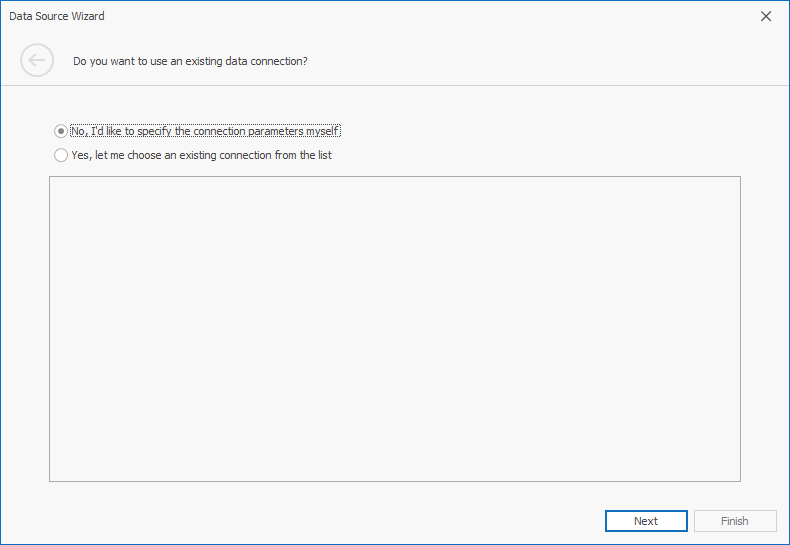SAP Sybase ASE
- 4 minutes to read
Invoke the Data Source Wizard to create a data source, connect to the database, and select the data. Another option is the API that allows you to perform the same tasks in code.
Important
The appropriate data provider must be installed on the client machine. For information on data providers, refer to the Data Sources article.
Create a Data Source in the Data Source Wizard
To connect to an SAP Sybase ASE database in the Dashboard Designer, follow the steps below:
Click the New Data Source button in the Data Source ribbon tab.

On the first page of the invoked Data Source Wizard dialog, specify whether you want to use an existing data connection or create a new data connection.

On the next page, select SAP Sybase ASE and click Next.

On the next page, specify the connection parameters.

Server name
Specifies the name of the SAP Sybase ASE database server to which the connection should be established.
User name
Specifies the user name used to authenticate to the SAP Sybase ASE database server.
Password
Specifies the password used to authenticate to the SAP Sybase ASE database server.
Database
Specifies the name of the database that contains data.
Tip
To specify the port number or other additional parameters, change Provider to Custom connection string and type in the connection string that contains the parameters.
Click Next and specify how to select data from the database.

You can choose from the following options:
Select the Query option and click Run Query Builder… to invoke the Query Builder. The Query Builder allows you to choose the tables/columns and passes the resulting SQL query to the SQL String editor. Subsequently, the text of the generated query returns to the Data Source wizard.

Click Finish to create the data source.
Note
If you apply filtering or use query parameters, click Next to specify the parameter settings.
Select the Stored Procedure option to select one of the stored procedures from the database.

Then click Next to specify the parameter settings.
On the final page, you can optionally add query parameters and preview data.

Click Finish to create the data source.
Create a Data Source in Code
To create a data source that uses a connection to the SAP Sybase ASE database, create an instance of the DashboardSqlDataSource class and follow the steps below:
Specify connection parameters for the SAP Sybase ASE database. Create the AseConnectionParameters class instance and specify the following properties:
- The ServerName property to specify the name of the server to which the connection should be established.
- The DatabaseName property to specify the name of the database to which the connection should be established.
- The UserName and Password properties to specify user credentials.
Assign the resulting AseConnectionParameters object to the DashboardSqlDataSource.ConnectionParameters property.
Note
Alternatively, you can add a connection string with parameters to the application configuration file. Then, assign the connection string name to the SqlDataSource.ConnectionName property.
Create one of the following query objects to retrieve data:
- Create a SelectQuery object to specify a set of tables/columns that form a SELECT statement when you execute a query.
- Create a CustomSqlQuery object to specify an SQL query. Use the CustomSqlQuery.Sql property to specify a custom query string.
- Create a StoredProcQuery object to execute a stored procedure call and supply the dashboard with data.
Add the created query to the DashboardSqlDataSource.Queries collection.
- Add the created DashboardSqlDataSource object to the Dashboard.DataSources collection.
The following code snippet shows how to supply the dashboard with data from the SAP Sybase ASE database:
using DevExpress.DashboardCommon;
using DevExpress.DataAccess.ConnectionParameters;
using DevExpress.DataAccess.Sql;
// ...
AseConnectionParameters aseParams = new AseConnectionParameters();
aseParams.ServerName = "localhost";
aseParams.DatabaseName = "Northwind";
aseParams.UserName = "Admin";
aseParams.Password = "password";
DashboardSqlDataSource sqlDataSource = new DashboardSqlDataSource("Data Source 1", aseParams);
SelectQuery selectQuery = SelectQueryFluentBuilder
.AddTable("SalesPerson")
.SelectColumns("CategoryName", "Extended Price")
.Build("Query 1");
sqlDataSource.Queries.Add(selectQuery);
sqlDataSource.Fill();
dashboard.DataSources.Add(sqlDataSource);